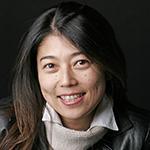
Faculty Profile: Naomi Kasumi, Digital Design
 Creating a new sacred space in one of the largest Buddhist training monasteries in Japan was challenging and humbling for Digital Design Professor Naomi Kasumi. In the fall of 2015, hundreds of thousands of people experienced “Sarit: Flow of Compassion” when they entered Soji-ji Temple in Yokohama during a month-long commemoration of the 650th anniversary of Daihonzan Soji-ji’s Second Abbot, Gasan Joseki Zenji.
Creating a new sacred space in one of the largest Buddhist training monasteries in Japan was challenging and humbling for Digital Design Professor Naomi Kasumi. In the fall of 2015, hundreds of thousands of people experienced “Sarit: Flow of Compassion” when they entered Soji-ji Temple in Yokohama during a month-long commemoration of the 650th anniversary of Daihonzan Soji-ji’s Second Abbot, Gasan Joseki Zenji.
For centuries, Soji-ji has been a Buddhist training monasteries in Japan. When Digital Design Professor Naomi Kasumi was commissioned by the monks to design a sacred space for the 650th anniversary of Daihonzan Soji-ji’s Second Abbot, Gasan Joseki Zenji, she visited the Soji-ji Temple in Yokohama three times to check out possible locations for an art installation. Following much deliberation, Kasumi and Temple leaders reached a consensus to install Sarit along the corridor in the main building, which measures 100 x 20 feet, once the site of a makeshift morgue following a train accident.
“I have done a lot of memorial work in Japan,” Kasumi said. “I knew that the hallway was the place I had to do a memorial not only for the Zen master but also for the victims of the train accident.”
Kasumi, who grew up in Kyoto, understands the traditions of the Soto Zen School. A continuous cycle of teaching, from generation to generation for hundreds of years, became the metaphor behind her installation, “Sarit: Flow of Compassion.” Sarit is Sanskrit for thread, stream, ocean, and the flow of time.
After months of researching and designing, in the winter of 2014 Kasumi began the lengthy process of making the elements that would be boxed, shipped, built, and installed on site in Japan in the summer of 2015. The first step was making more than 50,000 triangles out of dryer sheets.
Junior design student Mandy Rusch recalls standing in her dorm room ironing triangles and rounding the edges to make them lie flat.
“Professor Kasumi figured out that when the fibers in the used dryer sheets were coated with wax, they would reflect black light,” Rusch said. “She found the right ink so she could write on the triangles and tried out different types of fishing line to get the right effect when they were hung.”
In August 2015, with some pre-made segments shipped ahead and carting several boxes with her, Kasumi left Seattle to begin a 33-day residency at Soji-ji Temple to install Sarit. She worked with novice monks and community members to build frames, assemble the triangles, hang drapes, and install the segments.
“I needed to create a spiritual space different from everyday,” she said. “A black curtain functions to shift the emotional state when you enter and when you come out into the sun.”
The result was overwhelming. A deep blue color derives from black light that lets the fiber glow in the dark. Wax makes the white pigment shine whiter. There’s no sound in the space, just the hanging triangles gently touching each other when the air moves.
“That is a very important and very spiritual aspect of the artwork,” she emphasized. “You contemplate. You center yourself and something magical happens.”
Before leaving Yokohama, Kasumi talked with novice monks about the process and asked them to protect her work: “It was at that moment I felt really connected. It wasn’t that some artist came from the United States just to put a little crazy artwork in their building, but it was their work too. They were going to be responsible to protect it. It was a truly moving moment.”
For Rusch, the experience of working closely with Professor Kasumi opened a world of possibilities: “I realized how much art can be used in graphics besides just what you lay out with type or images digitally. As a digital design major you get used to using the computer so much and you want things to be efficient and fast, but for me the process behind creating something out of such a labor-intensive process was fascinating. The experience pushed me to take design outside the classroom in a lot of ways, and not only to think about the ways I want to look at a career in the future but the ways I want to apply art and design to my life.”
For Kasumi, sharing the creative process with students offers them insight into the discipline that is necessary for artists to succeed.
“To be an artist is a commitment, and we need the determination to complete artwork that inspires many other people,” she said. “I am proud to be an artist who completed a huge commission, but more than being proud, I am extremely grateful to have people and students who participated in my creative process and who are remain part of my life.”
Watch the video:
Published April 2016.